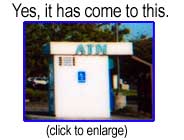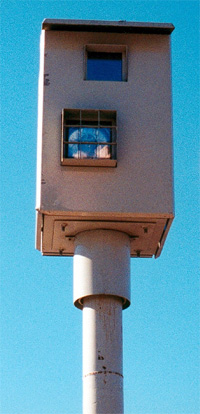Automated red-light enforcement is a sham: it's supporters claim that it improves traffic safety but it has not. Four years after this intrusive technology has been introduced in our state, there is no proof that it has significantly reduced traffic accidents at intersections. In San Francisco, the first city in California to install red-light cameras, a 10% reduction of collisions was noted at all intersections in the city, regardless of the presence or absence of cameras. Clearly there is no proof here that the cameras had any effect. The most simple conclusion is the best, that the trend toward safer driving in California is continuing.
 Despite the lack of any safety improvements by red-light cameras, San Francisco City coffers were enriched though millions in fines. Bay Area legislators also led the drive to increase red light fines in the state from $104 maximum to $346 maximum as of 1998. With no proof of any safety improvement but ample proof of profitability after 1998's fine increase, Lockheed-Martin had no problem marketing their automated money generators to many other cities in California, including San Diego. Perhaps the mayor was trying to find a way to pay for all those empty Chargers seats at the "Q."
Despite the lack of any safety improvements by red-light cameras, San Francisco City coffers were enriched though millions in fines. Bay Area legislators also led the drive to increase red light fines in the state from $104 maximum to $346 maximum as of 1998. With no proof of any safety improvement but ample proof of profitability after 1998's fine increase, Lockheed-Martin had no problem marketing their automated money generators to many other cities in California, including San Diego. Perhaps the mayor was trying to find a way to pay for all those empty Chargers seats at the "Q."
While teaching traffic school classes over the past five years, I have met a technician, a vice-president, and an attorney for the local corporation, US Public Technologies, that developed automated enforcement in California. They all attended my class as students. Each man told me the same story: the point of automated enforcement is to make money, not to decrease accidents or save lives, which it has proven unable to do. Safety, they told me, was used as a smokescreen to make these systems more palatable to the public. The technician specifically told me that the machines would be placed in areas where profits could be maximized. He also said that the company conducted market research to determine the most lucrative sites.
 Despite no evidence of accident reduction, the City of San Diego claims that it is installing these systems to decrease accidents and increase "safety." The city's claim is extremely suspect based on their choice of installation sites for the automated cameras. An article from the San Diego Union Tribune on 7-9-1996 dealing with the city's plan to install the original sixteen cameras systems noted the twenty most dangerous intersections in San Diego; these were the intersections with the highest number of accidents. The vast majority of these intersections are located in low-income working class neighborhoods (7 in City Heights alone) and in downtown San Diego. If this enforcement effort were at all about safety, one would expect that the cameras would be installed primarily at these identified dangerous intersections. However, only 2 of the 16 automated enforcement installations were done at any of these 20 most dangerous intersections (43rd Street and El Cajon Blvd. and 32nd Street and Harbor Drive). Why are only 2 of the 20 most dangerous intersections in San Diego fitted with red-light cameras if the primary goal of this program is to increase "safety?" Clearly this program is not about safety but about revenue generation for our stressed city coffers. The remaining fourteen cameras are installed in affluent and middle class neighborhoods: La Jolla, Pacific Beach, Rancho Bernardo, Carmel Mountain Ranch, Mira Mesa. These cameras have been installed in areas where drivers who can afford to pay an almost $300 ticket live and work. To ensure the financial success of Big Brother's latest incarnation, the City of San Diego and its corporate partners at Lockheed-Martin have avoided the low-income, high-accident areas where these machines may arguably promote safety, and installed them instead in safer but more affluent areas where cited drivers are more likely to be able to pay a $300 fine.
Despite no evidence of accident reduction, the City of San Diego claims that it is installing these systems to decrease accidents and increase "safety." The city's claim is extremely suspect based on their choice of installation sites for the automated cameras. An article from the San Diego Union Tribune on 7-9-1996 dealing with the city's plan to install the original sixteen cameras systems noted the twenty most dangerous intersections in San Diego; these were the intersections with the highest number of accidents. The vast majority of these intersections are located in low-income working class neighborhoods (7 in City Heights alone) and in downtown San Diego. If this enforcement effort were at all about safety, one would expect that the cameras would be installed primarily at these identified dangerous intersections. However, only 2 of the 16 automated enforcement installations were done at any of these 20 most dangerous intersections (43rd Street and El Cajon Blvd. and 32nd Street and Harbor Drive). Why are only 2 of the 20 most dangerous intersections in San Diego fitted with red-light cameras if the primary goal of this program is to increase "safety?" Clearly this program is not about safety but about revenue generation for our stressed city coffers. The remaining fourteen cameras are installed in affluent and middle class neighborhoods: La Jolla, Pacific Beach, Rancho Bernardo, Carmel Mountain Ranch, Mira Mesa. These cameras have been installed in areas where drivers who can afford to pay an almost $300 ticket live and work. To ensure the financial success of Big Brother's latest incarnation, the City of San Diego and its corporate partners at Lockheed-Martin have avoided the low-income, high-accident areas where these machines may arguably promote safety, and installed them instead in safer but more affluent areas where cited drivers are more likely to be able to pay a $300 fine.
In 1788 James Madison wrote, "Since the general civilization of mankind, I believe there are more instances of the abridgment of the freedom of the people by gradual and silent encroachments of those in power than by violent and sudden usurpations." I believe that automated enforcement is such an encroachment to our freedom. There is a built-in danger in integrating intrusive high technology and a corporation motivated only by profit into traffic law enforcement institutions, the police and traffic courts, whose primary goals should be only safety and justice. This danger is being fully realized today in San Diego. By the end of this year, there will be 32 intersections in San Diego monitored by cameras, double the number we had at the beginning of the year.
Since 1969 in California, citizens have been denied jury trials for alleged traffic infractions (Penal Code 19.6). As a result, the government alone arrests, prosecutes, and adjudicates traffic cases without any checks on their power that juries from the community usually provide in a democracy. Add to this already alarmingly unchecked power a profit motivated corporation and a witness-less prosecution which, lacking a citing officer who typically acts as prosecutor, is being essentially prosecuted by the judge himself. The judge's traditional role as an impartial arbitrator in these cases is no longer possible. If this isn't scary enough, the sworn testimony of human defendants is being disregarded in favor of machine-generated data provided courtesy of a company that only gets paid if you are found guilty.
Automated enforcement perverts the due process checks on the government's power guaranteed in our Constitution and should be vigorously resisted by all concerned citizens. Automated enforcement will go away once it becomes unprofitable. Encourage your friends, family, and coworkers to vigorously contest their automated enforcement citations. Contact your elected representatives and complain about their support for this system. Only through resistance by an informed citizenry can the malignant expansion of this technology, and the damage it has inflicted on our democracy, be checked and destroyed.
 Red-light Camera Tickets / Automated Enforcement is a Sham rant by Patrick Mulroy - The Ticket Assassin is licensed under a Creative Commons Attribution-NonCommercial-NoDerivatives 4.0 International License. You may freely distribute the above rant as long as it remains unaltered and the accreditation and link remains.
Red-light Camera Tickets / Automated Enforcement is a Sham rant by Patrick Mulroy - The Ticket Assassin is licensed under a Creative Commons Attribution-NonCommercial-NoDerivatives 4.0 International License. You may freely distribute the above rant as long as it remains unaltered and the accreditation and link remains.
Further reading for the truly pissed...
Automated Red Light Enforcement Only Targets Honest Citizens. Ticket Assassin explains the fundamental unfairness of automated enforcement: only honest citizens can be cited and made to pay.
Two State Laws Make Automated Enforcement Systems Illegal in California. Ticket Assassin examines the laws that render automated enforcement illegal in California.
The Smoking Gun. I always suspected that redlight cameras did nothing to increase traffic safety. Even the most optimistic stats showed single digit deceases in accidents often coupled by double digit increases in rear-end collisions. Why? Just because you decide to stop on yellow does not mean the Hummer behind you will. As a result, rear-end collisions have increased at intersections where redlight cameras are installed.
Now there is evidence that ALL TYPES OF ACCIDENTS may increase when cameras are installed. In Stockton, California, accidents have increased by 8% at the majority of intersections with redlight cameras. Over 15,000 citizens were cited at $338 each. This means that the city collected over $5,000,000 in fines to make its streets more dangerous. The city's response to the obvious failure of their camera program : they are installing two more cameras. I hope the local trauma centers are well-funded and can handle the increased business.
The "Technology Statement" Explained. The Ticket Assassin deconstructs the "Statement of Technology" issued with your Automated Enforcement ticket, pointing out the distortions, false assumptions, and outright lies promulgated by the police, the City of San Diego and Lockheed Martin in this "disinformation sheet."
A Better Mousetrap. By Cody Goodfellow. This article appeared in the November The Weekly, San Diego.
Smile and Say 'Fees'. By Jenifer Hanrahan. This article appeared in the San Diego Union Tribune.
